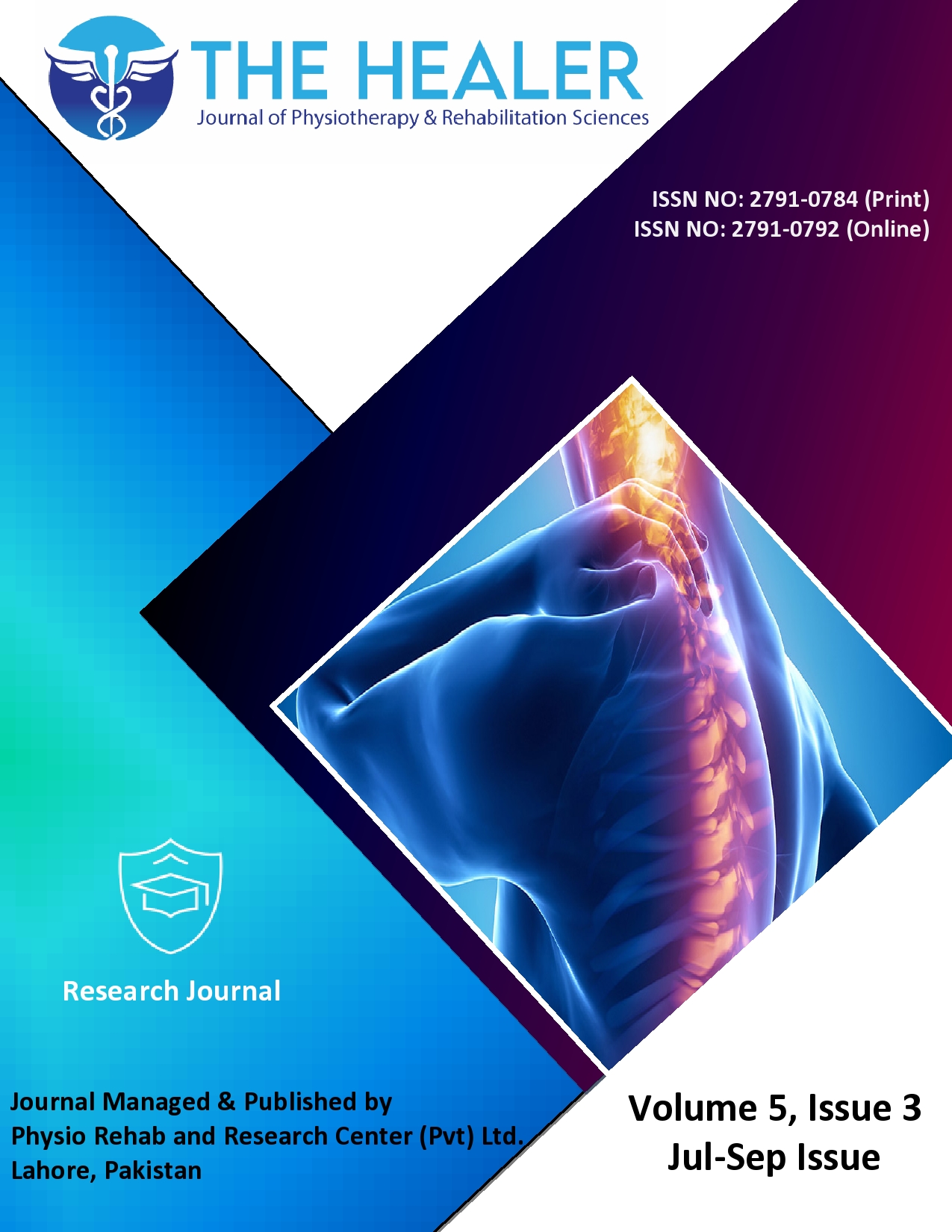Patient’s Perspective of In-Home Telerehabilitation Physiotherapy Services: A Cross-Sectional Survey
DOI:
https://doi.org/10.55735/rac2kk57Keywords:
Digital media , In-home telerehabilitation, Interactive communication, Patient’s perspective, Physiotherapy services, Technology usageAbstract
Background: Tele-rehabilitation is delivered remotely using digital media that can be audio or video recorded. With interactive communication technology, it is employed in a community setting to serve patient needs through diagnostic, restorative, preventive, motivating, and consulting services. Objective: To find the patients’ perception of in-home tele-rehabilitation physiotherapy services. Methodology: This cross-sectional study was conducted over a period of six months, data collected from the residents of Lahore. A total of 112 participants were enrolled in the study using a non-probability convenience sampling. Individuals aged 15 years and above, of either gender, who had experienced any form of musculoskeletal disorder. Participants were excluded if they presented with psychological disorders, chronic systemic illnesses (such as cardiovascular or respiratory conditions), or critical musculoskeletal injuries. Before participation, informed written consent was obtained from all eligible subjects. The data collection tool consisted of a self-administered questionnaire designed to assess participants’ perceptions of tele-rehabilitation. Age distribution was presented using a histogram, while other categorical variables were represented through bar charts. Results: The mean age of participants included in the study was 38.48±8.92 years. 21.4% of the participants were males, and 78.6% were females. 43.8% participants had secondary education, and 56.3% had graduated or had higher education. The study included participants from 10 different cities in Pakistan. The maximum number of participants was included from Lahore (33%) and Islamabad (25%). 58.9% participants took musculoskeletal or orthopedic services by tele-rehabilitation, 10 (8.9%) participants took pediatric services, 2 (1.8%) took neurology services, and 34 (30.4%) took occupational services. Conclusion: Majority of the participants were satisfied with tele-rehabilitation (53.6%) with most of the aspects of their experience, including the therapists’ competency (75%), the improvement in their medical condition (69.6%), the effectiveness of exercise program (67.9%), the technology, and the support provided by the technical team (85.7%). Most of the participants believed that management by tele-rehabilitation is as effective as face-to-face rehabilitation (54.5%).
Downloads
References
1. Brennan DM, Mawson S, Brownsell S. Telerehabilitation: enabling the remote delivery of healthcare, rehabilitation, and self-management. Studies in Health Technology And Informatics 2009; 145: 231-48.
2. Kairy D, Tousignant M, Leclerc N, Côté AM, Levasseur M, Researchers TT. The patient’s perspective of in-home telerehabilitation physiotherapy services following total knee arthroplasty. International Journal of Environmental Research and Public Health 2013; 10(9): 3998-4011.
https://doi.org/10.3390/ijerph10093998
3. Russell TG. Physical rehabilitation using telemedicine. Journal of Telemedicine and Telecare 2007; 13(5): 217-20.
https://doi.org/10.1258/135763307781458886
4. Latifi R. Current principles and practices of telemedicine and e-health: IOS Press; 2008.
5. Azma K, RezaSoltani Z, Rezaeimoghaddam F, Dadarkhah A, Mohsenolhosseini S. Efficacy of tele-rehabilitation compared with office-based physical therapy in patients with knee osteoarthritis: A randomized clinical trial. Journal of Telemedicine and Telecare 2018; 24(8): 560-5.
https://doi.org/10.1177/1357633X17723368
6. Broens TH, Huis in’t Veld RM, Vollenbroek-Hutten MM, Hermens HJ, van Halteren AT, Nieuwenhuis LJ. Determinants of successful telemedicine implementations: a literature study. Journal of Telemedicine and Telecare 2007; 13(6): 303-9.
https://doi.org/10.1258/135763307781644951
7. Cranen K, Drossaert CH, Brinkman ES, Braakman‐Jansen AL, IJzerman MJ, Vollenbroek‐Hutten MM. An exploration of chronic pain patients’ perceptions of home telerehabilitation services. Health Expectations: An International Journal of Public Participation in Health Care and Health Policy 2012; 15(4): 339-50.
https://doi.org/10.1111/j.1369-7625.2011.00668.x
8. Webster KA, Gribble PA. Functional rehabilitation interventions for chronic ankle instability: a systematic review. Journal of Sport Rehabilitation 2010; 19(1): 98-114.
https://doi.org/10.1123/jsr.19.1.98
9. Pierce-Williams RA, Saccone G, Berghella V. Hands-on versus hands-off techniques for the prevention of perineal trauma during vaginal delivery: a systematic review and meta-analysis of randomized controlled trials. The Journal of Maternal-Fetal & Neonatal Medicine 2021; 34(6): 993-1001.
https://doi.org/10.1080/14767058.2019.1619686
10. Algarni FS, Alshammari MO, Sidimohammad U, Khayat SA, Aljabbary A, Altowaijri AM. Tele-Rehabilitation Service from the Patient’s Perspective: A Cross-Sectional Study. Journal of Patient Experience 2022; 9: 23743735221130820.
https://doi.org/10.1177/23743735221130820
11. Hailey D, Roine R, Ohinmaa A, Dennett L. Evidence of benefit from telerehabilitation in routine care: a systematic review. Journal of Telemedicine and Telecare 2011; 17(6): 281-7.
https://doi.org/10.1258/jtt.2011.101208
12. Tousignant M, Boissy P, Moffet H, et al. Patients’ satisfaction with healthcare services and perception of in-home telerehabilitation and physiotherapists’ satisfaction with technology for post-knee arthroplasty: an embedded study in a randomized trial. Telemedicine Journal and E-Health 2011; 17(5): 376-82.
https://doi.org/10.1089/tmj.2010.0198
13. Zahid Z, Atique S, Hammad M, Iftikhar A, Shahid A, Malik R. A Commentary on Telerehabilitation Services in Pakistan: Current Trends and Future Possibilities. International Journal of Telerehabilitation 2017; 9(1): 71-6.
https://doi.org/10.5195/ijt.2017.6224
14. Rogante M, Grigioni M, Cordella D, Giacomozzi C. Ten years of telerehabilitation: A literature overview of technologies and clinical applications. NeuroRehabilitation 2010; 27(4): 287-304.
https://doi.org/10.3233/NRE-2010-0612
15. Ross MH, Nelson M, Parravicini V, et al. Staff perspectives on the key elements to successful rapid uptake of telerehabilitation in medium-sized public hospital physiotherapy departments. Physiotherapy Research International: The Journal for Researchers and Clinicians in Physical Therapy 2023; 28(3): e1991.
https://doi.org/10.1002/pri.1991
16. Jansson MM, Rantala A, Miettunen J, Puhto A-P, Pikkarainen M. The effects and safety of telerehabilitation in patients with lower-limb joint replacement: A systematic review and narrative synthesis. Journal of Telemedicine and Telecare 2022; 28(2): 96-114.
https://doi.org/10.1177/1357633X20917868
17. Albahrouh SI, Buabbas AJ. Physiotherapists’ perceptions of and willingness to use telerehabilitation in Kuwait during the COVID-19 pandemic. BMC Medical Informatics and Decision Making 2021; 21(1): 122.
https://doi.org/10.1186/s12911-021-01478-x
18. Tyagi S, Lim DSY, Ho WHH, et al. Acceptance of Tele-Rehabilitation by Stroke Patients: Perceived Barriers and Facilitators. Archives of Physical Medicine and Rehabilitation 2018; 99(12): 2472-2477.e2.
https://doi.org/10.1016/j.apmr.2018.04.033
19. Nelson MJ, Crossley KM, Bourke MG, Russell TG. Telerehabilitation Feasibility in Total Joint Replacement. International Journal of Telerehabilitation 2017; 9(2): 31-8.
https://doi.org/10.5195/ijt.2017.6235
20. Moffet H, Tousignant M, Nadeau S, et al. Patient Satisfaction with In-Home Telerehabilitation After Total Knee Arthroplasty: Results from a Randomized Controlled Trial. Telemedicine Journal and E-Health: The Official Journal of the American Telemedicine Association 2017; 23(2): 80-7.
https://doi.org/10.1089/tmj.2016.0060
21. Shukla H, Nair S, Thakker D. Role of telerehabilitation in patients following total knee arthroplasty: Evidence from a systematic literature review and meta-analysis. Journal of Telemedicine and Telecare 2017; 23(2): 339-46.
https://doi.org/10.1177/1357633X16628996
22. Moffet H, Tousignant M, Nadeau S, et al. In-Home Telerehabilitation Compared with Face-to-Face Rehabilitation After Total Knee Arthroplasty: A Noninferiority Randomized Controlled Trial. The Journal of Bone and Joint Surgery. American Volume 2015; 97(14): 1129-41.
https://doi.org/10.2106/JBJS.N.01066
23. Velayati F, Ayatollahi H, Hemmat M. A Systematic Review of the Effectiveness of Telerehabilitation Interventions for Therapeutic Purposes in the Elderly. Methods of Information in Medicine 2020; 59(2-03): 104-9.
https://doi.org/10.1055/s-0040-1713398
24. Buabbas AJ, Albahrouh SE, Alrowayeh HN, Alshawaf H. Telerehabilitation during the COVID-19 Pandemic: Patients and Physical Therapists’ Experiences. Medical Principles and Practice 2022; 31(2): 156-64.

Downloads
Published
License
Copyright (c) 2025 The Healer Journal of Physiotherapy and Rehabilitation Sciences

This work is licensed under a Creative Commons Attribution 4.0 International License.














